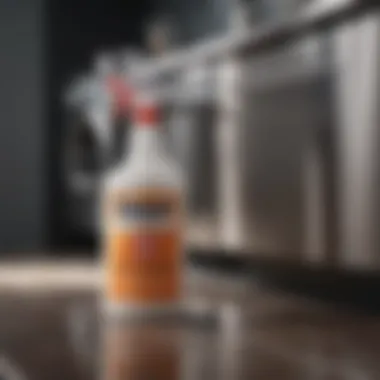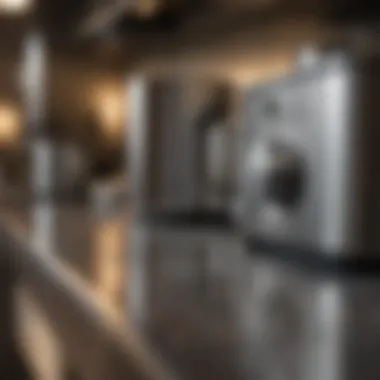Understanding Stained Stainless Steel Appliances


Intro
Stainless steel appliances are favored in modern kitchens for their sleek look and durability. However, their aesthetic nature often masks a common problem: stains. Understanding the causes behind these stains and the effective techniques for cleaning and maintaining these appliances is crucial for homeowners and design enthusiasts.
This article delves into the nature of stainless steel, common staining culprits, prevention tips, and cleaning methods. Engaging with this content will empower readers to preserve the elegance of their kitchen appliances, ensuring they maintain their visual integrity throughout their lifespan.
Prelims to Stainless Steel Appliances
Stainless steel appliances have become a staple in modern kitchens and an embodiment of elegance and functionality. Their sleek appearance is matched by their durability, making them a top choice for homeowners and designers alike. Understanding these appliances is crucial for maintaining their aesthetic appeal and functionality over time. In this article, we will discuss various aspects of stainless steel, especially focusing on stains that can detract from their beauty.
The Popularity of Stainless Steel
Stainless steel’s rise to popularity in kitchen design is largely due to its contemporary aesthetic and robust properties. Homeowners appreciate how it complements various decors, from modern to industrial. Its shiny surface offers a polished look, making kitchens feel more spacious and bright.
Moreover, stainless steel is highly resistant to corrosion and rust. This resistance ensures that appliances remain in excellent condition even with daily use. As more households adopt open-plan living, where kitchens are visible from living areas, the visual appeal of stainless steel becomes even more important. It allows homeowners to maintain a clean, cohesive look throughout their space.
Another key factor in the popularity of stainless steel appliances is their association with high-quality performance. Brands that produce these appliances often emphasize that they use high-grade materials. Consequently, buyers feel more secure that they are investing in products that will withstand the test of time.
Characteristics of Stainless Steel
Stainless steel consists primarily of iron, along with chromium and nickel. This unique combination grants several characteristics that make it desirable in appliance manufacturing.
1. Corrosion Resistance: Chromium forms a protective layer on the surface, preventing oxidation.
2. Durability: Stainless steel cannot easily chip or dent, making it ideal for high-use environments.
3. Low Maintenance: Its smooth surface resists collection of dirt and bacteria, allowing for easy cleaning.
Additionally, stainless steel is available in various finishes, including brushed and polished, providing options for diverse design tastes. Each finish impacts how fingerprints and smudges appear. While polished finishes may show marks more easily, brushed finishes tend to mask them better.
"A clear understanding of stainless steel helps homeowners select the right appliances and maintain them effectively."
As we proceed through this article, we will deepen our exploration of common stains, preventive measures, and cleaning techniques for stainless steel appliances, ensuring that they remain a focal point in your kitchen for years to come.
Understanding Stains on Stainless Steel
Stained stainless steel appliances present both an aesthetic and practical issue for homeowners and design enthusiasts. Understanding the nature of these stains is essential for maintaining the visual appeal and functionality of these fixtures. In modern kitchens, stainless steel is widely favored for its sleek appearance and resistance to corrosion. However, it is not immune to staining. By exploring common sources of stains and the way they form, one can appreciate the actionable steps required to preemptively address or rectify these blemishes.


Common Sources of Stains
Several factors contribute to the staining of stainless steel. Identifying these sources can help in developing preventive measures. Common contributors include:
- Water Marks: Water drips can leave behind unsightly mineral deposits.
- Food and Grease Residue: Cooking can lead to splatters that may not be immediately cleaned up, resulting in stains over time.
- Harsh Cleaning Products: Some cleaners can leave a residue that, when combined with dirt, leads to staining.
- Scratches: Surface abrasions can expose the metal beneath, leading to rusting and discoloration.
These elements not only detract from the visual charm of appliances but also hint at underlying maintenance issues. Understanding how daily use contributes to these stains can help homeowners adopt better habits.
How Stains Form
Staining on stainless steel is primarily a result of chemical reactions and external factors. Here’s how stains develop:
- Iron Particles: When stainless steel is scratched, iron particles can come into contact with air and moisture, leading to rust stains.
- Chemical Exposure: Certain substances, such as acidic or alkaline foods, can react with the top layer of the stainless steel, compromising its integrity and leading to staining.
- Environmental Factors: High humidity can increase the likelihood of stains as moisture exacerbates the reactions between iron particles and oxygen.
Understanding these processes is crucial. It allows homeowners to adopt specific cleaning and maintenance routines that mitigate the risk of stains. Being proactive in addressing the sources of stains can extend the life of stainless steel appliances and preserve their sleek look.
Preventing Stains on Stainless Steel Appliances
Stainless steel appliances are lauded for their sleek, modern appearance. However, they can easily become tarnished by everyday use. Preventing stains is crucial not only for maintaining visual appeal but also for extending the lifespan of your appliances. Understanding how to protect these surfaces can save homeowners from frustration and additional costs down the line.
Some specific elements to consider include routine maintenance and awareness of product interactions. By implementing effective prevention strategies, you can avoid common pitfalls. These include grease, fingerprints, and even food residue. Additionally, preventing stains ensures your appliances continue to enhance your kitchen's aesthetic.
Best Practices for Kitchen Use
Here are some practical best practices to adopt when using stainless steel appliances.
- Avoid Harsh Chemicals: Many cleaners contain harsh abrasives. These can scratch the surface of stainless steel, making it more prone to staining. Use gentle, non-abrasive cleaners.
- Wipe Down Surfaces Regularly: After cooking or using the appliances, take a moment to wipe them down. A soft cloth or a sponge will do. Do this to prevent food residue from settling in and staining the surface.
- Use Cutting Boards: Always use cutting boards when preparing food. This protects the counter and appliance surfaces from scratches that can harbor stains.
- Handle Cookware with Care: Be cautious when moving pots and pans. Avoid dragging metal cookware across the surface. This can create scratches, leading to staining.
Selecting Appropriate Cookware
Cookware choice can significantly impact the condition of your stainless steel appliances. Certain materials are safer than others. Here are some tips for selecting appropriate cookware:
- Opt for Non-Abrasive Materials: Stainless steel pots and pans are preferable. They do not scratch the surface as easily as cast iron.
- Avoid Heavy, Jagged Bottoms: Cookware with rough bottoms can damage appliances. Select pots and pans with smooth bases.
- Use Silicone or Wooden Utensils: When cooking, use utensils made from silicone or wood. Metal utensils can scratch surfaces, which can lead to staining in the long run.
By implementing these strategies, you can significantly reduce the likelihood of stains forming on your stainless steel appliances. These small changes in habits can provide substantial benefits in keeping your kitchen looking its best.
Effective Cleaning Techniques for Stainless Steel


Cleaning stainless steel appliances is crucial for maintaining their aesthetic and functional appeal. In an era where design and cleanliness are intertwined, these techniques offer solutions for many homeowners and design enthusiasts. The right cleaning methods not only enhance the appearance of your appliances but also protect them from long-term damage. Effective cleaning techniques can prevent stains, minimize fingerprints, and ensure that stainless steel retains its luster.
Basic Cleaning Solutions
The foundation of stainless steel maintenance lies in basic cleaning solutions. Simple mixtures can be remarkably effective. Here are some commonly used cleaning agents:
- Warm Water and Mild Soap: A mix of warm water with a few drops of mild dish soap is gentle yet effective for routine cleaning. This solution removes light dirt and grease without damaging the finish.
- Vinegar: This is a natural cleaner. Using white vinegar can help remove water spots and finger marks. Just spray it on and wipe away with a soft cloth.
- Baking Soda: A paste made from baking soda and water acts as a gentle abrasive. It can lift stubborn stains without scratching the surface.
When applying these solutions, use a soft cloth or microfiber towel. Avoid steel wool or abrasive pads, as they can cause scratches.
Using Specialized Stainless Steel Cleaners
For those tougher challenges, specialized stainless steel cleaners are available in the market. These products are formulated specifically for effective stainless steel maintenance. Many have been designed to combat specific issues:
- Fingerprint Resistant Formula: Many manufacturers offer cleaners that make surfaces less prone to fingerprints, ideal for frequently used appliances.
- Polishing Agents: These can provide an extra shine after cleaning and help protect against future stains and smudges. Products from brands like Weiman or Bar Keepers Friend are designed for this purpose.
- Stainless Steel Wipes: Convenient for quick cleanups, these wipes can provide a fast solution while being quite effective for maintaining appearance.
Using these specialized cleaners can offer benefits, such as ease of use and enhanced protective qualities. However, consider the type of cleaner based on appliance finishes.
Homemade Cleaning Solutions
Making your own cleaning solutions can save money and reduce reliance on commercial products. Some effective homemade alternatives include:
- Olive Oil and Vinegar: Mixing two tablespoons of olive oil with half a cup of vinegar can create an effective polish. Apply it with a soft cloth.
- Lemon Juice: Not only does it clean, but lemon juice can also leave a pleasant scent. A diluted mixture of lemon juice and water can clean and remove odors.
- Cornstarch: This might sound unusual, but it can help polish stainless steel when used dry. Apply a thin layer, buff with a soft cloth, and follow with a damp cloth.
Tip: Always test any cleaning solution on a small, inconspicuous area before applying it more broadly to ensure there is no adverse reaction.
Dealing with Tough Stains
Stains on stainless steel appliances can be frustrating, especially when they seem resistant to regular cleaning methods. This section emphasizes the significance of tackling tough stains. By understanding the nature of various stains, homeowners can adopt strategies that not only restore the appearance of their appliances but also prolong their life.
When tough stains remain, the aesthetic quality of the appliance is compromised. A clean kitchen enhances the overall ambiance of a home, making it essential to implement effective removal methods. Addressing drips, smudges, and stubborn discolorations improves not just the looks but the functionality of these impactful items in the kitchen.
Identifying Stain Types
Understanding the type of stain is a prerequisite for effective cleaning. Stains can originate from multiple sources, and recognizing them helps in selecting the right removal techniques. Here are some common types of stains:
- Water Spots: These are usually the result of hard water deposits that cake onto the surface.
- Food Residue: Grease or sauce that has been left to dry can leave a tough mark.
- Rust Stains: Metal utensils or containers may leave rust spots on stainless steel surfaces.
- Chemical Stains: These can come from cleaning agents that are overly abrasive or not suited for stainless steel.


Identifying the stain makes it easier to ascertain if a gentler cleaning method will suffice or if more intensive action is necessary.
Advanced Removal Techniques
Once the stain type is determined, it is time to employ sophisticated techniques tailored for specific stains. These methods ensure effective removal while keeping the integrity of the stainless steel intact.
- Baking Soda Paste: For tough food residue and grease, mix baking soda with a little water to form a paste. Apply this paste to the stain and let it sit for about ten minutes before scrubbing with a soft cloth or sponge.
- Vinegar Solution: For water spots, a solution of equal parts vinegar and water can work wonders. Spray it on the affected area, allow it to sit for a few minutes, and then wipe clean.
- Rust Remover: For rust stains, specially designed stainless steel rust removers are effective. Follow the manufacturer's instructions carefully to avoid damaging the surface.
- Diluted Bleach: In cases of extreme stubbornness, a diluted bleach solution may be applied, but this should be used cautiously to avoid corrosion.
It's important to always test any cleaning solution on a hidden area of the appliance first. This ensures that no damage will occur before applying it to the visible section.
Employing these advanced techniques provides homeowners with the tools needed to combat tough stains effectively. Regular attention to stains as soon as they appear prevents them from becoming permanent fixtures. By combining identification with targeted cleaning methods, stainless steel appliances can maintain their sheen and elegance.
Maintenance Tips for Longevity
Maintaining the aesthetic and functional integrity of stainless steel appliances is paramount for modern households. A proper maintenance routine ensures that these appliances not only stay visually appealing but also function efficiently over time. Regular upkeep prevents the formation of stubborn stains and protects against environmental damage. Here are key maintenance practices that contribute significantly to the longevity of stainless steel features in your kitchen.
Regular Cleaning Schedule
Establishing a regular cleaning schedule for your stainless steel appliances is crucial. Neglecting this can lead to the accumulation of dirt and grime, which can contribute to staining and corrosion. Ideally, a cleaning routine should be executed weekly or bi-weekly, depending on kitchen activity. Key steps include:
- Use a designated cleaner: Opt for a cleaner specifically designed for stainless steel. These products often contain ingredients that can help remove fingerprints and smudges without damaging the surface.
- Microfiber cloths: Always use a soft microfiber cloth for cleaning. This material can effectively trap dirt and reduce scratches compared to paper towels or sponges.
- Cleaners for tough jobs: Occasionally assess the appliance and use specialized cleaners for more difficult stains that appear between thorough cleanings.
Adhering to a cleaning schedule can also be a great opportunity to check for dents or scratches and manage any potential issues before they worsen.
Monitoring Environmental Factors
Monitoring environmental factors surrounding your appliances is equally important. These can significantly influence their appearance and functionality. Consider the following aspects:
- Humidity levels: High humidity can promote rusting. Installing a dehumidifier in the kitchen or keeping the area well-ventilated can prevent this issue.
- Temperature fluctuations: Rapid changes in temperature, especially near cooking areas, can affect stainless steel. Ensure that your appliances are positioned away from direct heat sources to maintain their integrity.
- Chemical exposure: Keep cleaners and other chemicals sealed and away from your appliances. Brief exposure can lead to lasting damage if spills or splashes occur.
Monitoring these elements can significantly reduce the risk of long-term damage to your stainless steel appliances. Remaining vigilant allows for prompt corrective actions before issues escalate.
By implementing these maintenance tips, homeowners can preserve the value and visual appeal of their stainless steel appliances, enhancing both functionality and aesthetics in kitchen environments.
Ending
Understanding how to care for stained stainless steel appliances is essential for maintaining their visual appeal and functionality. This article has highlighted the various aspects that affect the longevity and appearance of stainless steel items in your kitchen. From identifying common sources of stains to implementing preventive strategies, the insights provided help homeowners to better manage their appliances.
The Importance of Care
Caring for stainless steel appliances is not merely about aesthetics; it also impacts the overall performance and longevity of the products. Stainless steel, by design, is resistant to rust and corrosion, yet it can still show signs of wear and discoloration when not properly maintained.
- Preservation of Value: Regular care prevents stains and scratches, ensuring that appliances retain their value over time. Appliances that look pristine often have a higher resale value.
- Enhanced Aesthetic Appeal: Clean and shiny appliances complement modern kitchen designs. This means that proper maintenance contributes positively to the overall decor of the home.
- Practical Maintenance: Simple maintenance practices, such as a weekly cleaning routine, can significantly reduce the effort needed when dealing with tougher stains later on. Establishing this routine makes upkeep straightforward and less daunting.
- Environmental Considerations: Implementing appropriate cleaning practices can lessen the impact on the environment. Opting for eco-friendly cleaning solutions reduces harmful chemical usage in home maintenance.







